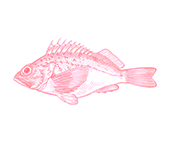




- Eat Less
Wild Caught
Region:
NT
- The Giant Mud Crab is found in tropical and sub-tropical coastal regions in the Indo-West Pacific. Mud crabs are caught in recreational and commercial fisheries across northern Australia.
- NT mud crab populations appear to be slightly below healthy levels, though recent scientific assessments were not available. This issue appears related to environmental impacts, and there is evidence that the populations have been recovering.
- NT mud crab fishery managers explicitly consider climate related factors in determining sustainable catch levels, which is welcome.
- The trap and pot fishing methods used likely have a low impact on threatened and endangered marine wildlife, though the fishery operates in areas that overlap with the habitat of species like dugongs, turtles and speartooth sharks and there have been reports of entanglements.
- The fishing methods used cause minimal habitat disturbance.





Mud crabs are highly regarded as eating crabs, a favourite for a table centrepiece whether steamed, stir-fried, or cooked in a curry or sauce. Crabs can be purchased whole (cooked or raw) or as picked and frozen meat. To cook whole crabs, crack any large legs or claws with the back of a knife and then steam, boil or stir-fry. Alternatively, crabs can be broken into equal sized pieces and dropped into a soup, stew or curry. Crabs are cooked when the shell goes a vivid orange or red colour and meat pulls away from the shell with ease. Cooked and picked crabmeat can be tossed through a simple pasta or noodle dish, or used for a seafood cocktail, salad or sandwich.
- NT Mud Crab Fishery (126t in 2019)
The Giant Mud Crab is found in tropical and sub-tropical coastal regions in the Indo-West Pacific. It is the most widespread mud crab species ranging from South Africa to Tahiti. In Australia the species is found from Shark Bay in WA to Port Hacking, south of Sydney. Commercial fisheries operate in QLD, NSW, WA and the NT.
The most recently available evidence suggests that NT mud crab populations are slightly below healthy levels, though this is driven by environmental impacts from successive poor wet season rainfall rather than overfishing. Populations are thought to be recovering but greater confidence would be supported by publication of more recent information.
Environmental and climate factors like rainfall, river flow and sea temperatures can affect mud crab fisheries significantly. An Australian study estimated 30-70% variability in commercial catches could be explained by these factors. It is proactive and welcome that NT fishery managers explicitly consider these factors in setting allowable future catches.
Mud crabs are mainly caught using baited pots, which are deployed the seafloor and remain in place until they are lifted up for harvest. These fishing methods pose a low risk to other species and vulnerable marine habitats.


